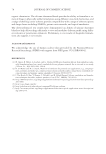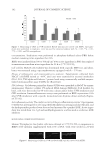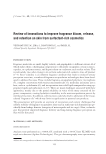JOURNAL OF COSMETIC SCIENCE 54 (3) M. Hashim, Y. O. Hamza, B. Yahia, F. M. Khogali, and G. I. Sulieman, Poisoning from henna dye and para-phenylenediamine mixtures in children in Khartoum’ Ann. Trop. Pediatr. 12, 3–6 (1992). (4) G. P. Hooff, N. A. van Huizen, R. J. W. Meesters, E. E. Zijlstra, M. Abdelraheem, W. Abdelraheem, M. Hamdouk, J. Lindemans, and T. M. Luider, Analytical investigations of toxic p-phenylenediamine (PPD) levels in clinical urine samples with special focus on MALDI-MS/MS. PLoS One 6(8), e22191 (2001). doi:10.1371/journal.pone.0022191 (5) E. Schultz and V. Mahler, Prolonged lichenoid reaction and cross-sensitivity to para-substituted amino- compounds due to temporary henna tattoo. Int. J. Dermatol., 41(5), 301–303 (2002). (6) W. Chen, T. A. Nkosi, S. Combrinck, A. M. Viljoen, and C. Cartwright-Jones, Rapid analysis of the skin irritant p-phenylenediamine (PPD) in henna products using atmospheric solids analysis probe mass spectrometry, J. Pharm. Biomed. Anal., 128, 119–125 (2016). (7) J. Roher, Rohrer’s Illustrated Book on Scientifi c Modern Beauty Culture. (Prof. Rohrer’s Institute of Beauty Culture, New York City, NY, 1924). (8) J. R. Ingram, T. M. Hughes, and N. M. Stone, Potential danger of hair dyes marketed as free from para- phenylenediamine, Int. J. Dermatol., 53(4), e257–e258 (2014). (9) G. Wellford. May 16, 2016. Why you should avoid “black henna” temporary tattoos this summer, Sunderland Echo, accessed June 11, 2016, http://www.sunderlandecho.com/news/why-you-should-avoid- black-henna-temporary-tattoos-this-summer-1-7913496#ixzz48ugP05H7 (10) B. I. Amro, Dyeing with henna and related materials, Thesis for PhD at the University of Wales (1989). (11) HPLC laboratory results, Alkemist Laboratories for TapDancing Lizard LLC, 2008–2016. (12) I. H. Amro, K. C. James, and T. D. Turner, A quantitative study of dyeing with lawsone, J. Soc. Cosmet. Chem., 45, 159–165 (1993). (13) F. Gallo, G. Multari, G. Palazzino, G. Pagliuca, S. M. M. Zadeh, P. C. N. Biapa, and M. Nicoletti, Henna through the centuries: A quick HPTLC analysis proposal to check identity, Revista Brasileira de Farmacognisia., 24, 2 (2014). (14) R. B. Semwala, D. K. Semwala, S. Combrinck, C. Cartwright-Jones, and A. Viljoen, Lawsonia inermis L. (henna): Ethnobotanical, phytochemical and pharmacological aspects. J. Ethnopharmacol., 155, 80–103 (2014). (15) K. G. Gilbert (nee Stoker) and D. T. Cooke, Dyes from plants: Past usage, present understanding and potential, Plant Growth Regulat., 34, 57–69 (2001). (16) C. Cartwright-Jones, The hammam” in The Oxford Encyclopedia of Islam and Women, N. J. DeLong-Bas, Ed. (Oxford University Press, 2013). (17) C. Cartwright-Jones, Ancient Sunrise Henna for Hair. TapDancing Lizard, http://www.tapdancinglizard. com/AS_henna_for_hair/index.html (2016).
J. Cosmet. Sci., 68, 55–58 ( January/February 2017) 55 An in vivo confocal Raman spectroscopic investigation of salicylic acid penetration: Variation with formulation parameters MARK A. DAVIES, Consumer Science, Ashland Specialty Ingredients. Abstract Salicylic acid (SA) is widely used in leave-on antiacne formulations, typically at a 2% level. As a β-hydroxy acid, it is a milder active ingredient than either α-hydroxy acids or benzoyl peroxide. SA is a keratolytic agent, a bacteriocide, and a comedolytic agent. For these reasons, improving the effi ciency of SA delivery is of interest. The objective of this work is to measure in vivo SA penetration from topically applied 2% SA leave-on products and to understand the penetration in terms of formulation parameters. Penetration of SA was measured in three depth zones—0–3 μm, 3–6 μm, and 6–9 μm below the surface—using in vivo confocal Raman spectroscopy. The delivery of SA from an emulsion, pH 4.0, and a hydrogel, pH 3.75, was compared and contrasted. A comparison of depth profi les reveals, e.g., signifi cant differences in SA distribution between-treatment profi les at various time points after treatment, particularly 3–6 μm below the surface. The hydrogel exhibited the higher normalized level of SA in the 3–6 μm depth zone. Confocal in vivo Raman spectroscopy is proving to be a valuable tool in determination of details of penetration of products into the skin. The penetration of various 2% SA anti-acne product forms will be compared and contrasted in this presentation. Delivery of SA will be discussed in terms of formulation parameters such as phase, pH, and specifi c ingredients and molecular-level interactions. INTRODUCTION Salicylic acid (SA) is a widely used active ingredient in antiacne products. It serves several functions—as a keratolytic agent, as a comedolytic agent, and as a bacteriocide. It is a β-hydroxy acid and is milder than α-hydroxy acids or benzoyl peroxide. Nevertheless, it can be irritating at a pH of 3–4, the pH range at which SA is most effi cacious in treat- ment of skin disease (1). One tactic for decreasing the irritation potential of SA is to control its delivery into the skin. The delivery of SA into the skin can be affected by formulation parameters (2). A major difference in the formulae tested here is the amount of ethanol and the matrix containing SA. Ethanol is known to be a skin penetration enhancer and is used in many transdermal formulae and patches. It can accomplish this function by several means. Ethanol may act as a solvent for the active of interest. In addition, it can aid in optimizing the solubility Address all correspondence to Mark Davies at MADavies@ashland.com.
Purchased for the exclusive use of nofirst nolast (unknown) From: SCC Media Library & Resource Center (library.scconline.org)












































































































































